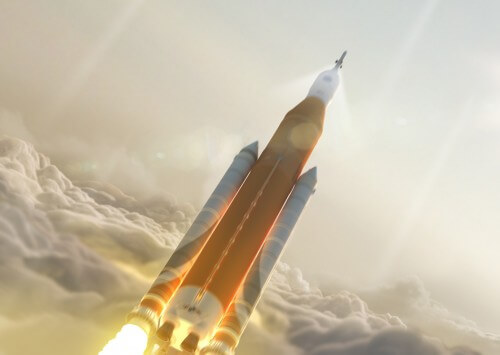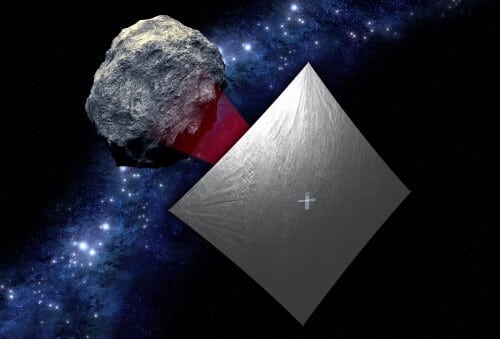NASA has announced that it will attach 13 tiny satellites called "Cubesats" to the first test flight of the SLS heavy launch vehicle in 2018, which NASA intends to use in the future to send astronauts to Mars

The new launcher that NASA is building is called SLS (Space Launch System) and is based on existing technology from the American space shuttles. It will be able to launch in its first test flight up to 70 tons (to low-Earth orbit), and in more advanced missions it is expected to undergo an upgrade that will include an advanced upper stage and then another upgrade in its side boosters, to increase the payload weight up to 130 tons.
The initial goal of the test flight, whose launch is currently planned to take place in November 2018, is to test the function of the new launcher and launch an unmanned Orion spacecraft into an orbit that will take it beyond the Moon and back to Earth, to test its function such as its ability to withstand the strong radiation levels in deep space and survive the entry into the Earth's atmosphere at a very high speed (much faster, for example, than the entry speed of the space shuttles).
As a secondary target, NASA Has announced On February 2, you will attach 13 tiny CubeSat satellites that will "catch a ride" on the launcher and take advantage of the free space left on it, as well as its unique trajectory that will take them far beyond low-Earth orbit into "deep space." Each of the satellites will be 6U in size (that is, six units of a cube measuring 10 x 10 x 10 cm). They will be attached to the launcher in a free space located in the cylinder that connects the Orion spacecraft to the upper stage of the launcher. Each of them will be launched into its orbit using a spring mechanism that will be activated after the Orion spacecraft detaches from the upper stage.

NASA senior Bill Hill said that "the SLS provides an incredible opportunity to perform scientific missions and test key technologies beyond low-Earth orbit." He added that "this launcher has an unprecedented ability to send [the spacecraft] Orion into deep space along with room to carry 13 small satellites - a payload that will advance our knowledge of deep space at minimal cost."
Three of the tiny satellites will be selected as part of a competition Cube Quest Challenge that NASA conducts and whose winners will be announced next year. Three more cubesats will be built as part of international partnerships. NASA did not specify which countries it would cooperate with, but said that discussions are already underway. Let's hope that Israel is one of them.
The remaining seven satellites have already been selected by NASA, and they include diverse tasks such as detecting and mapping water on the surface of the moon, studying asteroids, the solar wind and the effect of radiation in deep space on living beings. These satellites will also serve as technological demonstrators for innovative technologies such as solar sails and electric propulsion. The seven satellites announced:
- Skyfire - will fly near the moon and explore its surface. will be built by Lockheed Martin.
- Lunar IceCube - will try to locate water on the surface of the lunar soil using an infrared spectrometer, and will use experimental electric propulsion to enter orbit around the moon. Will be built by Morehead State University in Kentucky.
- Lunar Flashlight - will try to locate ice deposits inside the craters at the south pole of the moon, which due to their unique location are in perpetual darkness. The satellite will use a near-infrared laser to shine a light on these craters and try to locate and map the ice deposits within them. It will be built by a team from the Jet Propulsion Laboratory (JPL) and NASA's Marshall Space Flight Center.
- LunaH-Map - will also try to locate and map the ice deposits in the craters at the south pole of the moon, using a neutron detector capable of locating and mapping hydrogen atoms, which indicate the existence of water. Will be built by Arizona State University in partnership with JPL.
- Near-Earth Asteroid Scout - and NEA Scout for short, the satellite will use a solar sail that will take advantage of the constant (and very low) "push" of the sun's radiation to move through space and reach and study a near-Earth asteroid less than 100 meters in size.
- BioSentinel - Will examine the effect of radiation in deep space on yeast, and investigate the effect of exposure to radiation in deep space for an extended period of time on living beings.
- Cusp - Cubesat that will serve as a tracking and monitoring station for the solar wind, and will serve as a technological demonstrator for the viability and feasibility of a network of tiny satellites for monitoring the solar wind. The study of the solar wind is important in understanding the effect of the energetic particles that are spread everywhere by the sun, which may cause magnetic "storms" that can damage electronic equipment on Earth.

4 תגובות
Elisef, thank you. Everything you mentioned sounds right to me.
A question to Elisef Kosman how long the Shana crew will be on the space station as of today
Hi Yossi, it has nothing to do with the Atlas launcher, it's something completely different. You may be talking about the cancellation of the Ares 1 and 5 launchers that were in President Bush's Constellation program that President Obama canceled when he took office, and replaced it with the development of the SLS launcher (while continuing the development of the Orion spacecraft that had already begun in the Constellation program).
The privatization you are talking about does exist, but regarding what is known as "low-earth orbit" of up to several hundreds of kilometers above the earth, such as the orbit of the International Space Station. NASA is doing this in order to focus more on the development of the technologies that are required for activity in "deep space" such as in the vicinity of the moon and later also on Mars.
Regarding your second comment - I agree with you and NASA is indeed currently developing ion engines that operate on electric propulsion and is trying to perfect this technology to a level that would allow interplanetary travel such as the plan it is currently proposing to build a spacecraft that will operate on such technology, and deliver a rock from an asteroid close to- Earth to orbit around the moon. However, there is currently no existing or even emerging technology to replace rocket launchers into space, which is what the SLS launcher is for.
I thought NASA was privatizing the issue of spacecraft and launchers and disabled the development of Atlas. If anyone knows otherwise I would love to hear.
Second, there is no use for a long journey in rocket engines. A technology is required in which it is not necessary to carry an increasing amount of fuel with the distance, and it is not necessary to turn off the engine between the source and the destination.
Is there an insistence on staying in the nearest space.